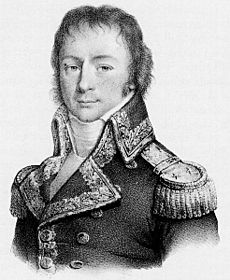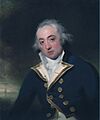Action of 18 June 1799 facts for kids
Quick facts for kids Action of 18 June 1799 |
|||||||
|---|---|---|---|---|---|---|---|
| Part of the French Revolutionary Wars in the wake of the Mediterranean campaign of 1798 | |||||||
|
|||||||
| Belligerents | |||||||
| Commanders and leaders | |||||||
| Contre-Admiral Jean-Baptiste Perrée | John Markham | ||||||
| Strength | |||||||
|
Three frigates and two brigs
|
Three ships of the line and two frigates
|
||||||
| Casualties and losses | |||||||
| All ships captured | |||||||
The Action of 18 June 1799 was a sea battle during the French Revolutionary Wars. It happened near Toulon, France, shortly after the Mediterranean campaign of 1798.
A group of French ships, led by Rear-admiral Perrée, was sailing back to Toulon from Syria. They ran into a much larger British fleet of 30 ships, commanded by Lord Keith.
Three big British warships and two smaller ones broke off to chase the French. This chase lasted for 28 hours. When the British ships finally caught up, the French ships had to give up because they were greatly outnumbered.
Contents
Why This Battle Happened
The French Campaign in Egypt and Syria
The French campaign in Egypt and Syria started in 1798. The French Navy's Toulon fleet, led by Vice-admiral Brueys, carried about 40,000 soldiers to Egypt. The army, led by General Bonaparte, landed successfully. They won battles against the Ottomans and Mameluks.
However, the British Navy, under Admiral Nelson, destroyed most of the French fleet. This happened at the Battle of the Nile.
After losing so many ships at the Battle of the Nile, France had few naval forces left in the area. Napoleon used the captured French sailors, whom Nelson had released, for duties on land or on small boats on the Nile River.
The remaining French frigates were very important. They could help the army by blocking enemy forts and attacking shore targets. They also carried supplies. Their powerful 18-pounder cannons were like heavy siege guns for the army. Their artillery and ammunition could be used in land battles.
The French campaign then moved east, especially with the Siege of Acre. Rear-admiral Perrée was put in charge of a small group of ships. These ships were some of the few that survived the Battle of the Nile.
His mission was to deliver supplies and cannons to the army. This was difficult because the Ottoman and British navies were blocking the area.
Perrée's Squadron
Perrée's group included three frigates and two brigs:
- The frigate Junon (Commander Pourquier)
- The frigate Courageuse (Captain Trullet)
- The frigate Alceste (Captain Barré)
- The brig Salamine (Lieutenant Landry)
- The brig Alerte (Demay)
After reaching Jaffa, the frigates unloaded their cargo. They also shared their ammunition with the army. This left the frigates with only 15 shots per cannon. Junon even gave up four of her 18-pounder cannons. The ships then helped block the Siege of Acre.
On May 14, two enemy warships and a frigate, led by Sidney Smith, chased Perrée's ships. But Perrée's squadron quickly got away. Perrée had orders not to go to Europe unless it was absolutely necessary. However, he talked with his officers. They decided that they had so few supplies that they had to return to Toulon. They planned to stop at Lampedusa to get more water.
The Battle Begins
On June 17, 1799, about 60 miles from Toulon, Perrée's ships saw a large British fleet. This fleet had 30 ships and was led by Lord Keith.
A smaller group of British ships broke away to chase the French. This group included three large 74-gun warships and two frigates. Captain John Markham on HMS Centaur led this British task force.
The Long Chase
The wind was very light, blowing weakly from the southwest. Because of this, the chase lasted a very long time, about 28 hours. The two groups of ships did not meet until the next evening.
As the French ships sailed northwest, they spread out. By evening, Junon and Alceste were sailing close together. Courageuse was about one mile away from her flagship. The brigs Salamine and Alerte were even further ahead, four and seven miles from Junon.
French Ships Surrender
At 7:00 PM, the 74-gun HMS Bellona, led by Thompson, got very close to Junon. HMS Captain and two frigates were right behind Bellona.
When Bellona started firing, Junon and Alceste quickly lowered their flags, meaning they surrendered.
Meanwhile, HMS Centaur had caught up to Courageuse and began firing. After getting Junon and Alceste to surrender, HMS Bellona joined the fight against Courageuse. With two large 74-gun ships attacking her, Courageuse also surrendered.
Later, HMS Emerald caught Salamine and forced her to surrender. Similarly, HMS Captain made Alerte surrender at 11:30 PM.
A report on July 26 said that Lord Keith's squadron had captured Alceste (36 guns, 460 men), Juno (44 guns, 560 men), Courageuse (44 guns, 500 men), and two smaller ships (16 guns each).
What Happened Next
Perrée, who had been taken prisoner, was quickly exchanged. He faced a military court from October 6 to November 25, 1799. The court, led by Vice-admiral Thévenard, looked into why he lost his ships.
The court found that Perrée had good reasons to return to Toulon. These reasons included the strong enemy forces near Syria, his ships having fewer cannons, and low food and water supplies. The court decided that Perrée was innocent and cleared his name.
The British Navy took Junon and renamed her HMS Princess Charlotte. Courageuse was also taken, but she soon became a prison ship, likely in Malta. Alceste was used as a floating battery. The British Navy also took Alerte and renamed her HMS Minorca. Salamine became HMS Salamine. She served in the Mediterranean and captured two privateer ships.
After the Treaty of Amiens in 1802, the British Navy got rid of Alceste, Alerte, and Salamine.
Images for kids





